kandy korn jig heads
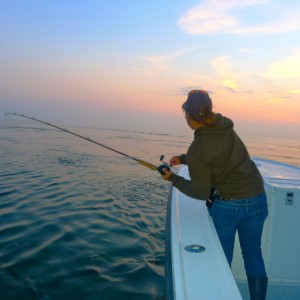 In the last CLT entry, I wrote about the five reasons why Chesapeake Bay stripers attack a lure: hunger, reaction, competition, territory protection, and curiosity. When fish are hungry, they’re easy to catch. Almost any lure or technique will work on hunger-feeding fish. Unfortunately, most of us don’t have the time or resources to constantly run around looking for schools of voracious fish. If you’re like me, you have to fish in the limited time you have available, and you probably stay close to home. While we may occasionally happen upon groups of ravenous fish, most of the stripers we encounter are hard to catch. In order to be consistently successful, we have to provoke strikes from fish that may not be particularly inclined to bite. Strike producing lures are especially important right now since we have trophy rockfish migrating in and out of the Bay. Our chances for catching-and-releasing a 50-pounder on light tackle are better than at any other time of year, but migrating fish have other things on their minds besides eating. Big fish get bigger by being smart and getting smarter. To catch them, we need to cast lures that will provoke strikes by appealing to their five senses; sight, sound, smell, feel and taste. I call the formula 5 by 5. By that, I mean we can consider the five reasons why fish strike, then use lures designed to appeal to each of their five senses in order to come up with the best of all possible strike triggers. In this installment we’ll look at striped bass eyesight. Read More!
In the last CLT entry, I wrote about the five reasons why Chesapeake Bay stripers attack a lure: hunger, reaction, competition, territory protection, and curiosity. When fish are hungry, they’re easy to catch. Almost any lure or technique will work on hunger-feeding fish. Unfortunately, most of us don’t have the time or resources to constantly run around looking for schools of voracious fish. If you’re like me, you have to fish in the limited time you have available, and you probably stay close to home. While we may occasionally happen upon groups of ravenous fish, most of the stripers we encounter are hard to catch. In order to be consistently successful, we have to provoke strikes from fish that may not be particularly inclined to bite. Strike producing lures are especially important right now since we have trophy rockfish migrating in and out of the Bay. Our chances for catching-and-releasing a 50-pounder on light tackle are better than at any other time of year, but migrating fish have other things on their minds besides eating. Big fish get bigger by being smart and getting smarter. To catch them, we need to cast lures that will provoke strikes by appealing to their five senses; sight, sound, smell, feel and taste. I call the formula 5 by 5. By that, I mean we can consider the five reasons why fish strike, then use lures designed to appeal to each of their five senses in order to come up with the best of all possible strike triggers. In this installment we’ll look at striped bass eyesight. Read More!
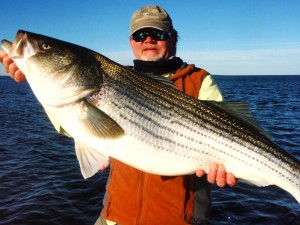 If the next 51 weeks of 2012 go as well as the first one, this promises to be a very good year for light tackle fishing on the Chesapeake Bay. I’ve fished four times and caught a Diamond Jim qualifying citation fish on each trip including three rockfish in the mid 40-inch range. I’m chalking it up to a little experience, some insider information, and a lot of luck. My son, “Big Fish Cory” has been visiting. Although he didn’t catch any trophies this time around, he still brought along his lucky horseshoe. Chesapeake striped bass fishermen have two basic winter options. One is to fish deep holes – either in the main stem of the Bay or up in the outside bends of the rivers – and the other is to work the warm water discharges. Since we’ve had a very mild winter so far, the warm water discharges have been inconsistent. I decided to split the difference and fish the last four days close to home off Kent Island.
If the next 51 weeks of 2012 go as well as the first one, this promises to be a very good year for light tackle fishing on the Chesapeake Bay. I’ve fished four times and caught a Diamond Jim qualifying citation fish on each trip including three rockfish in the mid 40-inch range. I’m chalking it up to a little experience, some insider information, and a lot of luck. My son, “Big Fish Cory” has been visiting. Although he didn’t catch any trophies this time around, he still brought along his lucky horseshoe. Chesapeake striped bass fishermen have two basic winter options. One is to fish deep holes – either in the main stem of the Bay or up in the outside bends of the rivers – and the other is to work the warm water discharges. Since we’ve had a very mild winter so far, the warm water discharges have been inconsistent. I decided to split the difference and fish the last four days close to home off Kent Island.
One of the best places I know of to jig up deep water rockfish is the Bay Bridge. Two- and three-year-old-stripers and white perch survive the cold winter by stacking up around the Bay Bridge rock piles. They’ll stay there until the spring freshet washes out their warm water comfort zones. Even though they are readily apparent on a fish finder, they aren’t always easy to catch. To coax a strike out of deep-water stripers you just have to aggravate them until they bite. You can jig for hours and not get a single strike, then, snap – the fish will turn on and you’re catching every cast. Read More!
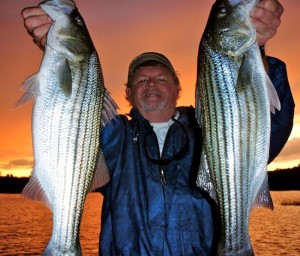 There is a harmony in autumn, and a luster in its sky, which through the summer is not heard or seen, as if it could not be, as if it had not been! ~Percy Bysshe Shelley
There is a harmony in autumn, and a luster in its sky, which through the summer is not heard or seen, as if it could not be, as if it had not been! ~Percy Bysshe Shelley
Is there anything more dramatic than an October sky? If I had my way there would be an eternal high tide, a full moon every night, and the skies would always glow like they do in Autumn. There’s a chill in the Chesapeake air tonight, signaling that fall is here and October fishing has begun. Just like they have the past three years in a row, bigger fish have arrived in the shallows of the mid and upper Bay. The pattern hasn’t changed from last week: topwater plugs in the shallows are still producing, but the exciting difference is that now there are significantly more 30-inch rockfish in the mix. Nothing beats big stripers exploding on surface plugs beneath the technicolor skies of October. Read More!
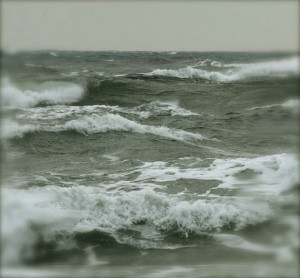 At least they must have been precious in his sight last weekend when an epic spring storm kept many fishermen off the Bay on the opening day of Maryland’s striped bass catch-and-kill season. Water temperatures are lower than usual this April, so there are lots of pre-spawn fish still moving up the Bay. I’d guess at least a couple of thousand more roe-laden cows made it to the spawning grounds this weekend that otherwise wouldn’t have, but for the storms. Let’s hope that translates into millions of additional baby rockfish. Even though I usually root for the fish, I still get excited about opening weekend because the recreational rockfish season in Maryland is definitely worth celebrating. With all the commercial poaching we saw this winter, it’s amazing to me that there are any fish left to catch. Since there are still a few around, let’s thank the Lord for that too!
At least they must have been precious in his sight last weekend when an epic spring storm kept many fishermen off the Bay on the opening day of Maryland’s striped bass catch-and-kill season. Water temperatures are lower than usual this April, so there are lots of pre-spawn fish still moving up the Bay. I’d guess at least a couple of thousand more roe-laden cows made it to the spawning grounds this weekend that otherwise wouldn’t have, but for the storms. Let’s hope that translates into millions of additional baby rockfish. Even though I usually root for the fish, I still get excited about opening weekend because the recreational rockfish season in Maryland is definitely worth celebrating. With all the commercial poaching we saw this winter, it’s amazing to me that there are any fish left to catch. Since there are still a few around, let’s thank the Lord for that too!
 If you’ve ever traveled to Memphis, Tennessee, chances are good that you visited the Peabody Hotel lobby to see the world-famous mallards march down the red carpet. It’s a time-honored tradition that dates back to the 1930s when a couple of hunters from Arkansas decided it would be funny to put some live ducks in the hotel’s indoor fountain. The famous Peabody Marching Mallards have appeared on The Tonight Show, Sesame Street, The Oprah Winfrey Show, in People magazine and even graced the pages of the Sports Illustrated Swimsuit Issue. If you read the Peabody’s website, you’ll find that those lucky ducks are raised by a local farmer who loans them to the hotel. What you won’t read is that the farmer who provides the Peabody ducks is also an excellent fisherman. I know that for a fact because I fished with him all week. Read More!
If you’ve ever traveled to Memphis, Tennessee, chances are good that you visited the Peabody Hotel lobby to see the world-famous mallards march down the red carpet. It’s a time-honored tradition that dates back to the 1930s when a couple of hunters from Arkansas decided it would be funny to put some live ducks in the hotel’s indoor fountain. The famous Peabody Marching Mallards have appeared on The Tonight Show, Sesame Street, The Oprah Winfrey Show, in People magazine and even graced the pages of the Sports Illustrated Swimsuit Issue. If you read the Peabody’s website, you’ll find that those lucky ducks are raised by a local farmer who loans them to the hotel. What you won’t read is that the farmer who provides the Peabody ducks is also an excellent fisherman. I know that for a fact because I fished with him all week. Read More!
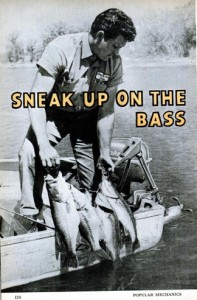 “Show me a fisherman and I’ll show you a scoundrel and a sneak,” says well-known outdoor writer Bob Lawless. I don’t hang out with too many scoundrels, but every good fisherman I know is a sneak. In an article about newly-invented trolling motors, the April 1960 edition of Popular Mechanics offers this observation: “Big fish don’t get to be bigger fish by being dumb. They get big by learning to recognize predators in their midst.” Stealth is one of fishing’s primary skills.
“Show me a fisherman and I’ll show you a scoundrel and a sneak,” says well-known outdoor writer Bob Lawless. I don’t hang out with too many scoundrels, but every good fisherman I know is a sneak. In an article about newly-invented trolling motors, the April 1960 edition of Popular Mechanics offers this observation: “Big fish don’t get to be bigger fish by being dumb. They get big by learning to recognize predators in their midst.” Stealth is one of fishing’s primary skills.
By swimming and scuba diving I’ve learned that some sounds are easily transferred through the water. Surface conversations can be heard down to about fifteen feet while the thump of loud music or an object falling onto the deck of a boat can be detected even deeper. The most recognizable underwater noise is made by running outboards and whirling props.
Some fishermen are so careful about noise that they won’t even turn on their sonar units when they know they’re over fish. It’s been proven that fish can detect the pings. I’m not always that sneaky, but I’ve learned a little something over the years about how important stealth can be. Take a look at the monster light tackle stripers in this report and you’ll see what I mean!


